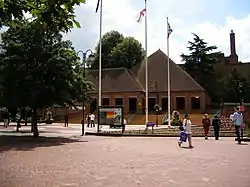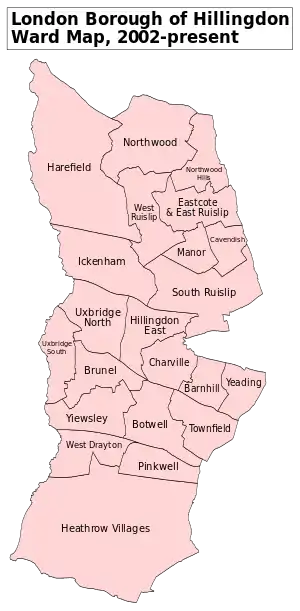Hillingdon London Borough Council
Hillingdon London Borough Council[lower-alpha 1] is the local authority for the London Borough of Hillingdon in Greater London, England. It is a London borough council, one of 32 in the United Kingdom capital of London. Hillingdon is divided into 22 wards, electing a total of 65 councillors.[4] The council was created by the London Government Act 1963 and replaced four local authorities: Uxbridge Borough Council, Hayes and Harlington Urban District Council, Ruislip-Northwood Urban District Council and Yiewsley and West Drayton Urban District Council.
Hillingdon Council | |
|---|---|
 | |
| Type | |
| Type | |
| History | |
| Founded | 1 April 1965 |
| Leadership | |
Mayor of Hillingdon | Cllr Teji Barnes (Con) since 14 May 2020 |
Leader of the Council | |
Chief executive | Fran Beasley since 19 October 2012 |
| Structure | |
| Seats | 65 councillors |
 | |
Political groups |
|
Length of term | 4 years |
| Elections | |
| First past the post | |
Last election | 3 May 2018 |
| Meeting place | |
 | |
| Hillingdon Civic Centre, Uxbridge | |
| Website | |
| www | |
History

There have previously been a number of local authorities responsible for the Hilligdon area. The current local authority was first elected in 1964, a year before formally coming into its powers and prior to the creation of the London Borough of Hillingdon on 1 April 1965. Hillingdon replaced Uxbridge Borough Council, Hayes and Harlington Urban District Council, Ruislip-Northwood Urban District Council and Yiewsley and West Drayton Urban District Council.[5]
It was envisaged, in accordance with the London Government Act 1963, that Hillingdon as a London local authority would share power with the Greater London Council. The split of powers and functions meant that the Greater London Council was responsible for "wide area" services such as fire, ambulance, flood prevention, and refuse disposal; with the local authorities responsible for "personal" services such as social care, libraries, cemeteries and refuse collection. As an outer London borough council it has been an education authority since 1965. This arrangement lasted until 1986 when Hillingdon London Borough Council gained responsibility for some services that had been provided by the Greater London Council, such as waste disposal. Since 2000 the Greater London Authority has taken some responsibility for highways and planning control from the council, but within the English local government system the council remains a "most purpose" authority in terms of the available range of powers and functions.[6]
Powers and functions
The local authority derives its powers and functions from the London Government Act 1963 and subsequent legislation. Hillingdon has the powers and functions of a London borough council. It is a billing authority collecting Council Tax and business rates, it processes local planning applications, and it is responsible for housing, waste collection and environmental health. It is a local education authority, responsible for social services, libraries and waste disposal. The council shares responsibility with the Greater London Authority for strategic policies including housing, planning and the environment.[7]
Finances
Hillingdon London Borough Council is the billing authority for Council Tax, and collects precepts on behalf of the Mayor's Office for Policing and Crime, the London Fire and Emergency Planning Authority the Greater London Authority and Transport for London.[8]
Summary results of elections
The council has been alternated between Conservative, Labour Party and no overall control since it was first elected in 1964.
| Party in control | Years | |
|---|---|---|
| Labour | 1964 - 1968 | |
| Conservative | 1968 - 1971 | |
| Labour | 1971 - 1978 | |
| Conservative | 1978 - 1986 | |
| No overall control | 1986 - 1990 | |
| Conservative | 1990 - 1994 | |
| Labour | 1994 - 1998 | |
| No overall control | 1998 - 2006 | |
| Conservative | 2006–present | |
Notes
References
- "Councillor Ian Edwards". Hillingdon London Borough Council. Retrieved 15 January 2021.
- The Local Authorities (Categorisation) (England) Order 2006, SI 2006/3096, art 5
- "Constitution". London Borough of Hillingdon. Retrieved 19 March 2018.
- "Councillors". Who runs London.
- Youngs, Frederic (1979). Guide to the Local Administrative Units of England. I: Southern England. London: Royal Historical Society. ISBN 0-901050-67-9.
- Leach, Steve (1998). Local Government Reorganisation: The Review and its Aftermath. Routledge. p. 107. ISBN 978-0714648590.
- "Local Plan Responses – within and outside London". Mayor of London. Retrieved 9 April 2020.
- "Council Tax and Business Rates Billing Authorities". Council Tax Rates. Retrieved 8 April 2020.
